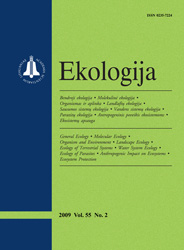 ISSN 0235-7224 ISSN 2029-0586 (online) |
2009 m. Nr. 2 Effect of long-term industrial pollution on microorganisms in soil of deciduous forests situated along a pollution gradient next to a fertilizer factory. 2. Abundance and diversity of soil fungi
Abundance of fungi and their species diversity in soil of seven deciduous forests situated at a distance of 0.7, 3, 4, 5, 8, 9 and 15 km from a chemical factory in Lithuania were investigated. Fungal abundance and species composition were determined by the colony count technique and identification by macro- and micro-morphological observations of fungal cultures after subculture on potato dextrose agar, malt extract agar, cornmeal agar, Czapek’s agar and Sabouroud agar media. The number of fungi viable on the isolation media negatively correlated (r = –0.58) with the distance from the pollution source and with the content of some heavy metals in soil (r = – 0.46, –0.44 and –0.35, As, Cr and Zn, respectively). A positive correlation between fungal abundance and the content of nutrients, organic mater and water in soil (r = 0.77, 0.88, 0.74 and 0.46, for N, P, OMC and WC, respectively) was observed. In contrast to the abundance, the number of isolated fungal genera (and species) positively correlated with the distance from the factory and heavy metal content in soil. A lower fungus diversity in more polluted soils provided evidence that pollution may reduce the suitability of forest soil as a habitat for specific groups of fungi, such as the genera Geomyces and Acremonium and some species of the Penicillium and Trichoderma genera. Other fungi (Paecilomyces, Talaromyces, Beauveria genera and sterile mycelia forms) were abundant in the soil of more polluted forest plots. Keywords: deciduous forest, fungal communities, abundance, diversity, pollution effects, heavy metals, resistance |
Issues:
2011 - Vol.57 No. 1, No. 2 2010 - Vol.56 No. 1-2, No. 3-4 2009 - Vol.55 No. 1, No. 2, No. 3-4 2008 - Vol.54 No. 1, No. 2, No. 3, No. 4 2007 - Vol.53 No. 1, No. 2, No. 2.priedas, No. 3, No. 4 2006 No. 1, No. 2, No. 3, No. 4 2005 No. 1, No. 2, No. 3, No. 4 2004 No. 1, No. 2, No. 3, No. 4 2003 No. 1, No. 2, No. 3, No. 4 2002 No. 1, No. 2, No. 3, No. 4 2001 No. 1, No. 2, No. 3, No. 4 |